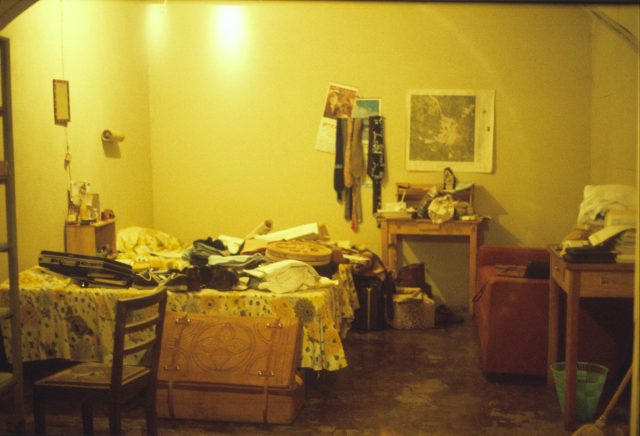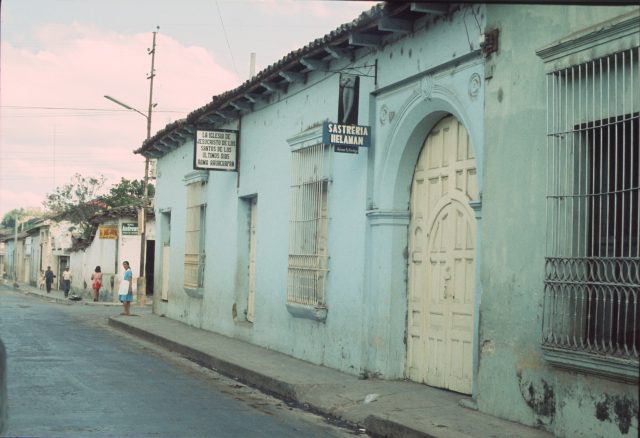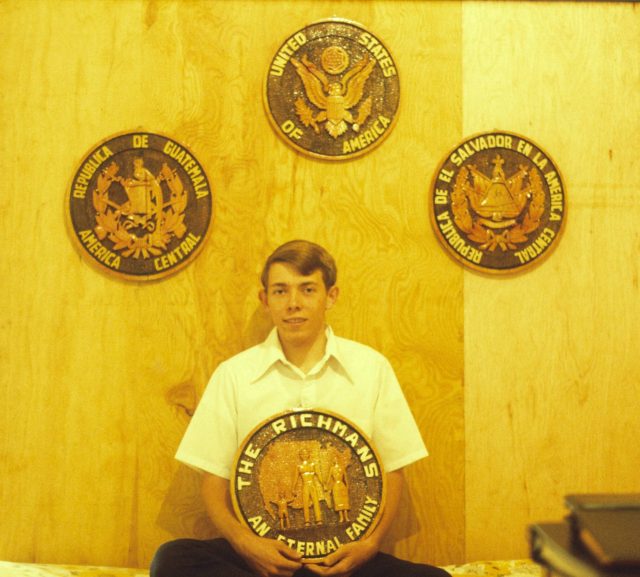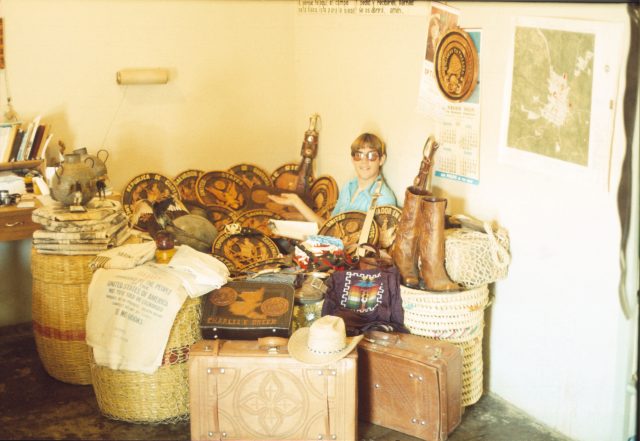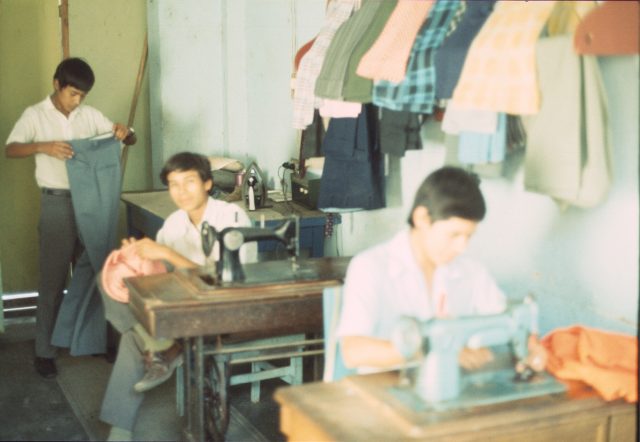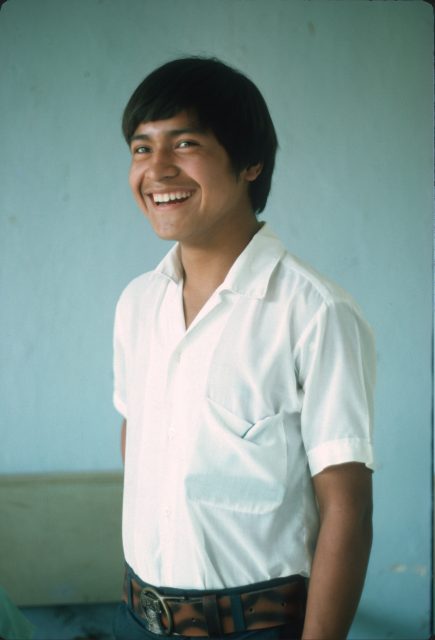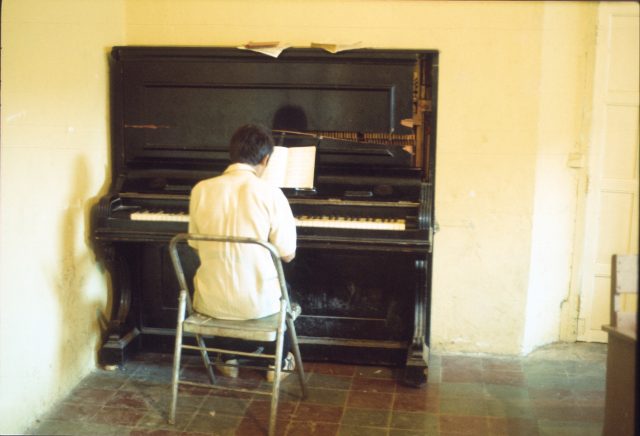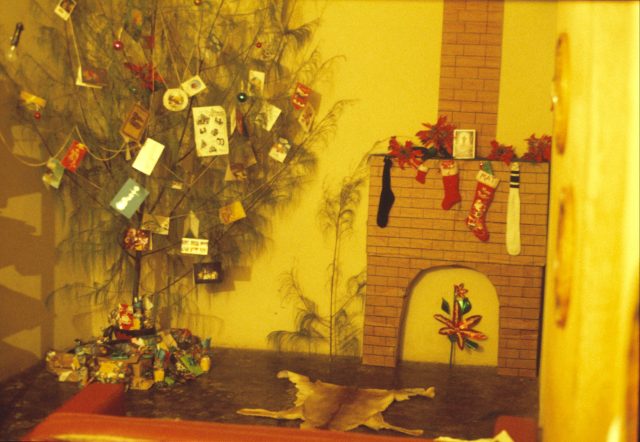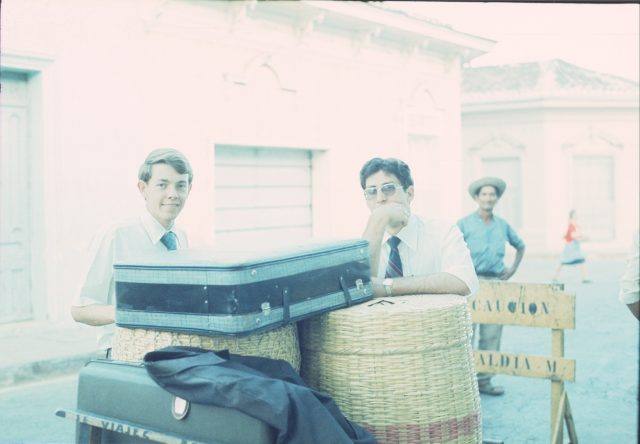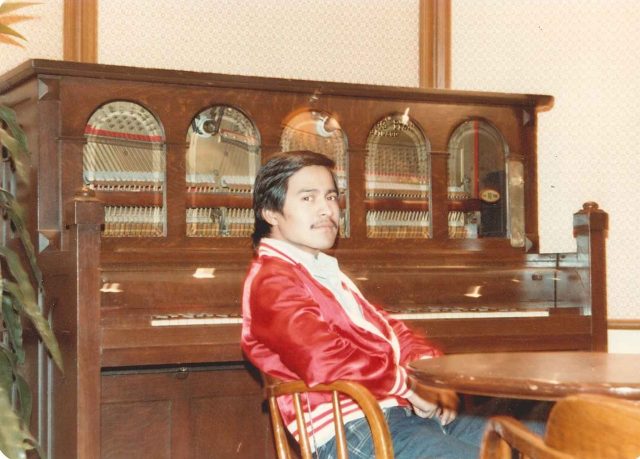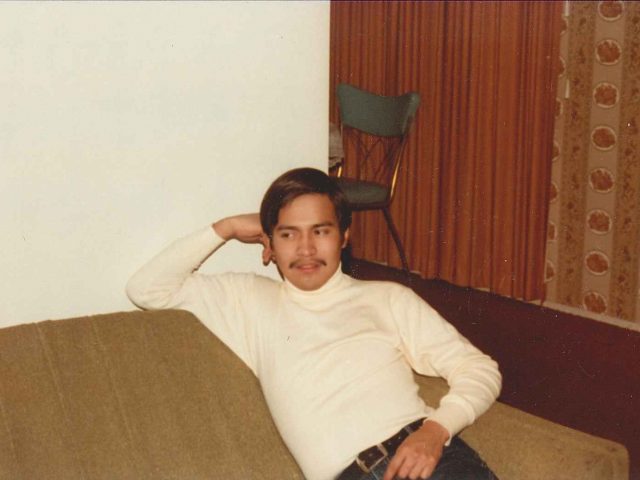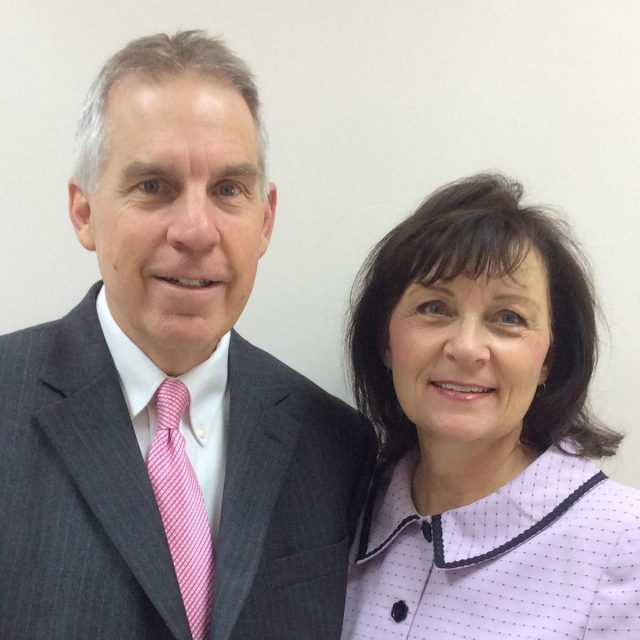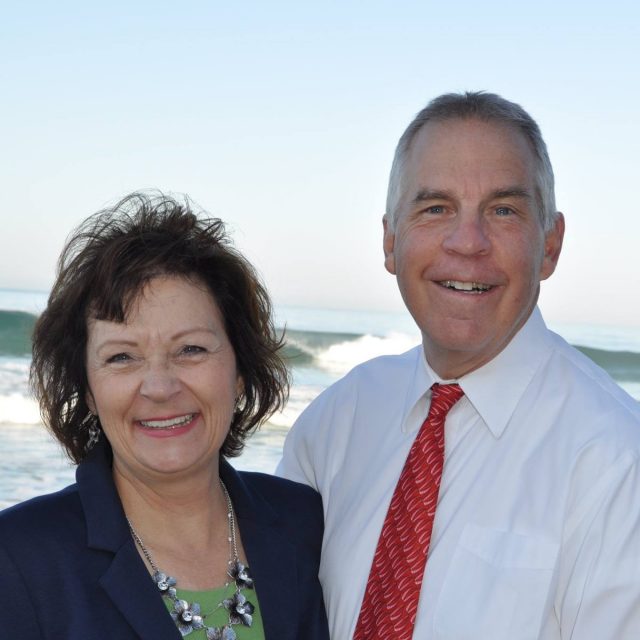Ahuachapán, El Salvador
I arrived in the mission field on October 3, 1974. After one night in the mission home in Guatemala City, I was assigned to Ahuachapán, El Salvador. (Ahuachapán was the name of our district in the LTM!) So, we boarded a Tika Bus headed for El Salvador.
Tika bus that missionaries used to travel from Guatemala to El Salvador
Ahuachapán was a city of about 19,000 people. We lived in a house with 3–4 other boarders. The landlady’s name was Lily Lagos.
Soon after I arrived and dropped off my bags, we went out to visit some investigators. What I was told was true—I didn’t understand hardly anything that people said in Spanish. We visited a man and gave him the baptismal challenge and he accepted it. I had a wonderful feeling sitting there. His house was about 20 feet by 20 feet with a dirt floor. In one corner was a wood-burning brick stove filling the house with smoke. An old, dirty plastic tablecloth was draped across the other corner which was the bedroom. His old mother stood over the fire stirring food in a little pot.
The church was a rented building with a baptismal font in the courtyard that had a spiderweb across it, which I hoped wasn’t an indication of how often the font was used. That turned out not to be the case, because on October 12, I baptized José Antonio Hernandez Sierra, a man that Elder Greer had been teaching. Then on November 2, I baptized a 15-year-old girl that we taught, Marta Laguán.
The first Sunday I was there, we took a bus to the small town of Apaneca where a lady (member of the Church who was born there, but then lived in the capital city of San Salvador) had arranged for use to talk with 6–7 families. They all wanted to hear the discussions. This dear sister introduced us as special messengers from the Lord who had the authority to preach the gospel and to baptize. I was impressed how she introduced us and knew that what she said was who we really were! One of her friends was about 80 years old and 4’ 11.” She was very happy to see us and asked if we would teach her the gospel even though she was poor. We assured her that the gospel was for everyone, rich or poor. When we left, she hugged us as though we were her own children. It was really touching. We went back to Apaneca several times to teach people.
Shortly thereafter, we taught a lady who lived in a house made from two living trees as supports, with a grass roof and bamboo sticks and cardboard for walls. She paid 5 colones a month, which included electricity for her one light bulb. She and her husband were separated, and she received nothing from him to support their five children. She made candy and the two older boys sold it in town and at school. During the lessons, one of us sat on a chair and the other on a wooden box. The family sat on the two beds (the only other furniture in the house). The mother and her five children slept on the two beds with two sheets per bed. None of the children had shoes and the only clothes they had were the clothes they wore. But the children were clean, well mannered, and had dignity. The poor people were humble.
I really appreciated my companion, Elder Mathew Greer. He only had 3 months left on his mission but worked very hard. He was easy to get along with and we worked together well. One Sunday, we had 13 hours of effective time (time with investigators), not counting morning study hours or time for eating. In a good week, I studied 23 hours, and we had 61.5 hours effective time with investigators. Elder Greer really loved the people and did not get upset with cultural differences. When we would get dross in the street from young people, he would be friendly and stop and talk with them. Before long, we seldom got dross because all the kids around like us.
Several times, we visited a member who was in the prison in town. There were lots of men packed into small spaces. Some of them made wood carvings to sell. Lots of missionaries bought shields with the emblems of the United States or of El Salvador. I ordered several shields with carved figures of a family with the words “The Richmans: An Eternal Family.”
On one visit, the prison was packed because they had just been “recruiting” young men to serve in the military. They would go around town and gather up all the young men they could find and put them in jail. They would then train them to be soldiers—whether they liked it or not—and would serve in the military for 18 months. There were many parents there that day begging for their sons to be released. They released a few back to their parents, but those who didn’t get claimed didn’t have a chance to get out.
On October 18, we went to San Salvador for a two-zone conference. As part of the conference, we watched the movie “Where the Red Fern Grows.” Doctor Doty is a medical missionary here. He was the executive producer of the film, and we watched his personal copy of it. He was part of Doty-Dayton Productions.
The Catholic school Colegio Josefina next to our house had a Bible class for a week during summer break, and for some reason, the Catholic priest, Padre Gabriel, wanted us to teach it. Before the class, we visited with him in the convent, and he laid out the rule that we were to teach only from the Bible. He was an interesting character. He had long hair and dressed in the latest fads. In his office, there was a full ash tray on the table, bongo drums in the corner, and large speakers in the corner. After we left, the band came into his office with guitars and drums to practice for next Sunday’s services.
One day, we taught a man the lesson about the commandments. As we talked about keeping the sabbath day holy, he asked why we recognize Sunday (rather than Saturday) as the day of worship. He had been talking with Seventh Day Adventists, and he retrieved a stack of literature from his cabinet to prove his point. As he was getting ready to defend his position, we explained that it all boiled down to one thing—if you believe that Joseph Smith was a prophet, then God spoke to him and told him that Sunday is the day to worship. That stopped the man cold. All the paper he had in front of him turned worthless, and he couldn’t think of a thing to say. We asked him what he wanted to explain to us from his material. But he just folded up the notebook, set it aside, and said, “maybe it would be better not to.”
One day, we tracted out a Jehovah’s Witness family. Our affectionate name for Testigos de Jehová was TJ. We had a short discussion about why there had to be a restoration of the gospel. They pulled out their green dragons (our affectionate name for their green Bibles) and tried to prove that Jehovah is God the Father. We showed them several scriptures that showed that He is not. They did not believe that Joseph Smith was a prophet because the Bible does not tell his story. We explained that the Bible was written anciently, and the restoration took place in modern times, but it didn’t make any difference to them. We agreed to come back the next Friday. We fully expected that they would invite Joseph (the head of the Jehovah’s Witnesses in Ahuachapán).
The next Friday, we showed up to a room filled with chairs and green Bibles. There were 15 TJs there. Joseph wasn’t there, but another TJ leader was there. We explained that last Friday and tonight we were there to explain the restoration of the gospel and not to dispute scriptures. We asked permission to give the entire lesson without interruptions, saying we would leave time at the end for questions. They all agreed to the arrangement, but nevertheless kept interrupting with scriptures to read. Elder Greer answered all their questions very well and we kept the lesson moving. At one point, the leader said, “I can agree that Joseph Smith was visited by a spirit and told to organize a church but…” Elder Greer knew what he was going to say, so Elder Greer said it first, “…but that spirit was the devil.” And the whole room burst out laughing because it sounded so ludicrous. We saw the leader’s jaw drop as he realized that even his followers didn’t believe such as claim. We certainly had the help of the Spirit with us. At the end of the lesson, the leader asked to give the prayer. He asked “Jehovah, the Father,” to help them stay in the truth and not be misled by the things they heard from us. It was quite an experience, and I learned a lot that night.
On November 15, we got two additional missionaries in Ahuachapán—Elder Terry K. Dalton and Elder Gordon R. Billings. See companions page.
I really grew to love people in the Ahuachapán Branch. There were about 300 members of record, but only 50–75 attended. Key people in the branch included the following:
Lito and Dalila Síntigo. Lito was the oldest of the Síntigo brothers. He was an English teacher at a school in Santa Ana. His wife Dalila was not a member. We taught her since I arrived in Ahuachapán, but she did not see a need to be rebaptized (with the proper authority). But on November 2, she finally received her answer and wanted to be baptized. A few days later, her doctor advised against being baptized because she was pregnant and hadn’t been feeling well. He said she should wait until after the baby was born in April. Later that month, she gave birth prematurely, but the boy only lived 3 hours. They named the boy after Elder Greer. Dalila was finally baptized on December 21, just before I was transferred out of Ahuachapán. Elder Greer baptized her, and her husband confirmed her.
Jaime Síntigo was a counselor in the branch presidency. He owned (and lived in) the Sastrería Helamán tailor shop next to the church and worked there with his brothers Jesús and Rutílio (and another young man Ernesto “Neto” Centeno). Jaime did most of the work in the branch presidency, as the president, Luís Angel Figero, worked out of town and was only there on Sundays. Benjamín “Mincho” Rivas was the other counselor. Jamie was planning to go on a mission after the first of the year when his divorce was final.
Jorge Síntigo was completely inactive. Read the account at the end of this section about his murder on December 21.
Jesús Síntigo was another of the Síntigo brothers (Lito, Jaime, Jorge, Jesús, and Rutílio). He was 18 years old.
Rutílio (Ruti) Síntigo also worked at the tailor shop. I helped him learn the basics of playing the piano. I taught him to play what I remembered of “Love Story” and “Romeo and Juliet.” He loved postage stamps, so I gave him all the stamps from my letters. I encouraged him to get ready to serve a mission and stay faithful in the Church. After I left Ahuachapán, and throughout the mission, I wrote letters to him and to other members of the Síntigo family. I encouraged Rutílio to prepare to serve a mission and to keep practicing the piano so he could play the piano in the new church when it was built.
Our district included the town of Chalchuapa, with Elders Evans and Lidtka.
The mission had a “Yo Pertenezco” (“I Belong”) program. Many cities had large banners and posters in shop windows. The program taught that I belong to three things: the house of Israel, an eternal family, and the kingdom of God on earth.
One day, Mom wrote in a letter wondering why the Church sends missionaries all over the world when there are so many people back home who need the gospel. I responded, “Well, that’s why there is only one of me here and nine of you still at home.”
On December 1, John O’Donnal, first counselor to President Arnold in the mission presidency [who toward the end of my mission became my mission president], attended church and announced plans to build a meetinghouse in Ahuachapán beginning in January.
On December 16, at the end of a missionary conference, as President Arnold was leaving, he said “see you after Christmas, unless you get a reassignment before then, Elder Richman.” Elder Greer and I ran over to his car door and said, “President, just forget that there is anyone in Ahuachapán.” But, sure enough, on December 27, I was moved to Retalhuleu, one of the hottest places in the mission.
On Sunday, December 21, we showed up at priesthood meeting to find out that Jorge Síntigo had been murdered at 11:45 pm the night before by a drunk. We went to their house to talk with the family and help them get ready for the funeral which was at 4:00 pm that day. (The law requires deceased people to be buried within 24 hours.) I tried to console the family and shared with them that my mother had passed away just three years ago. The family was distraught, not just because they had lost their brother, but because he was completely inactive in the church. I reassured them that he would still have the chance to repent, and that they could be an eternal family. I had “adopted” the Síntigos as my second family and I felt their pain acutely. I don’t know how I came to love them so much in just 11 weeks.
At the graveside, Brother Rivas (a counselor in the branch presidency) gave a short talk before the dedicatory prayer. Sacrament meeting that day was at 7:00 pm because of the funeral. I just could not pull myself away from the church after the meeting. I had to talk with everyone and say my final goodbyes. I hadn’t realized how much the people loved me. Many of them were sad to see me leave.
December 24 was my first Christmas Eve away from home. We sang Christmas carols to people at the hospital and gave out candy to the kids. The branch had a program at the church at 7:30 pm, with talks, songs, and dinner. I was sure glad to be able to see people in the branch one more time before I left. We then had a program at home with the six missionaries in the district. Christmas is celebrated differently in El Salvador than in the states. People get drunk and the kids shoot off fireworks.
On Christmas Day, we opened presents around our cardboard fireplace and artificial tree with 7 Christmas bulbs. At 5:00 pm Elder Greer and I went to visit members and at 8:00 pm went up to the lot where the new church meetinghouse will be built (by the prison) to help the members clear out the dried corn stocks. By 9:00 pm, the members ended their work, leaving a third of the lot to be cleared over the next two nights. After the closing prayer and song, Elder Greer, Jaime, Manual Rivas, his cousin, and I decided to keep working, and in half an hour had the rest of the field cleared and the corn stocks burned.
December 27 was my last day in Ahuachapán. At 6:00 am, we took Elders Greer and Billings to the bus terminal to go to Santa Ana to get Elder Greer’s new companion. Elder Dalton and I then rented a handcart and went back to the house to get our belongings.
We stopped by the Sastrería Helamán tailor shop to say goodbye. When it was time for us to go to the park to catch the Tica bus, they closed the shop and came with us. When Rutílio left, he said, “I’ll never forget you.” A few minutes later, Lito, Dalila, Sister Síntigo, and Rita drove up. Dalila and Lito gave me a book as a going away present and she said, “the arms of Ahuachapán are always open for you.” It was about as hard to leave them as it had been to leave my family at the airport at the beginning of my mission.
Note: I don’t have many photos of the people in Ahuachapán because they were lost in shipment.
After the Mission
The week of March 14, 1982, I received a letter from Dalila Síntigo. Her husband was just ordained a bishop and she was the ward Relief Society president. She said that even with all the trouble in El Salvador, they were happy. A few weeks later, I got a letter from Rutílio. He was living in Van Nuyes, California. I tried to find his phone number to call him but could not.
Mathew Greer
Out of the blue, on April 23, 2018, Mathew Greer sent me a friend request on Facebook. Mat was my first missionary companion in Ahuachapán, El Salvador. I responded, “Thanks for the friend request. Are you the Mathew Greer who was my senior companion in Ahuachapán from October 5 to December 27, 1974?” He answered, “Quehuvole! That would be me, my friend. I found your blog recently and was flooded with most excellent memories of my time with one of the best new missionaries I had the pleasure to work with. Hope your life is excellent! We just returned from a beautiful time in the Mexico Xalapa Mission and loved it! Senior missionaries are the best! #justserve”
I responded, “What a pleasure to connect with you after all these years. I remember going to your wedding reception shortly after I returned from my mission, but I haven’t seen you since. I assume you saw your picture at http://larryrichman.org/mission/companions-lds.html.”
“My life is excellent. I stayed close to Guatemala for years, involved in translation work among the Indians there. I’ve been back to Guatemala many times, but only returned to El Salvador twice. I have pictures of the Síntigo family from Ahuachapán. I’ll have to find them and post them at http://larryrichman.org/mission/ahuachapan.html.”
After posting the pictures, he responded, “Too many most excellent memories! Thanks for being a part of who I have become through experiencing your dedicated example. Happy Sabbath!”
Mathew and his wife served as mission president in the Mexico Xalapa Mission, July 2014–2017.
Mathew Charles Greer, 60, and Terrilyn Haynes Greer, four children, Elliot Ward, Gilbert Arizona Stake: Mexico Xalapa Mission, succeeding President Paulo Lopez and Sister Josefina Melo de Lopez. Brother and Sister Greer recently served as Perpetual Education Fund missionaries in the Honduras Tegucigalpa Mission. Brother Greer is a former stake Young Men president, bishop, stake executive secretary, institute teacher, temple ordinance worker and missionary in the Guatemala/El Salvador Mission. Retired senior account manager, Alcon Labs. Born in Provo, Utah, to Charles Edward Greer and Barbara Ann Johnson Greer.
Sister Greer is a former counselor in a stake Relief Society presidency, ward Young Women president, Relief Society compassionate service leader, temple ordinance worker and ward missionary. Born in Provo, Utah, to Lawrence Clark Haynes and Ardath LaRue Olsen Haynes.
On March 17, 2019, I received the following email from Mat. I had just sent an email to Area Presidencies and Mat and his wife are serving as the executive secretary to the Caribbean Area Presidency.
Well, hello there young ex-companion!
And how did you know you could find me down here….? Sister Greer and I are just starting our 18 months working in the area office as exec secs. I was thrilled to see your smiling face attached to this memo, usually you are attached to the Guatemala/El Salvador web page, so it was a treat to see you!
Just wanted to say hi, and to remind you that you are part of some very fond memories, even if I did try to walk you to death in Ahuachapán! (I never was the most organized missionary there was, maybe that’s why the Lord called me here….)
Happy Sabbath!
My response:
Hey Elder Greer,
Nice to hear from you! I also have very fond memories of Ahuachapán. Of all the companions I had during the mission, you stand out as one of the best. Thanks for your great example of dedication that got me off on the right foot for my entire mission!
His reply:
And for the record you were the best new companion I trained. I loved how absolutely teachable you always were, and I’m sure that attribute has served you well. I am under no misconception to think I was anything special as a missionary, but notwithstanding my weaknesses now we have the opportunity to give a bit again, and we are unbelievably blessed to be called to work with Elders Gonzalez, Alonso, and Gavarret—as observers basically. This continues to be a tutorial adventure for both Terri and I, and we love it.
So, get out there as soon as you can, you will be amazed how needed you were when you get to where you are sent. I am eternally grateful that the Lord blessed us with the ability to go out some 5 years ago! Keep the faith my young friend!
Gratefully Sent from our iPad


